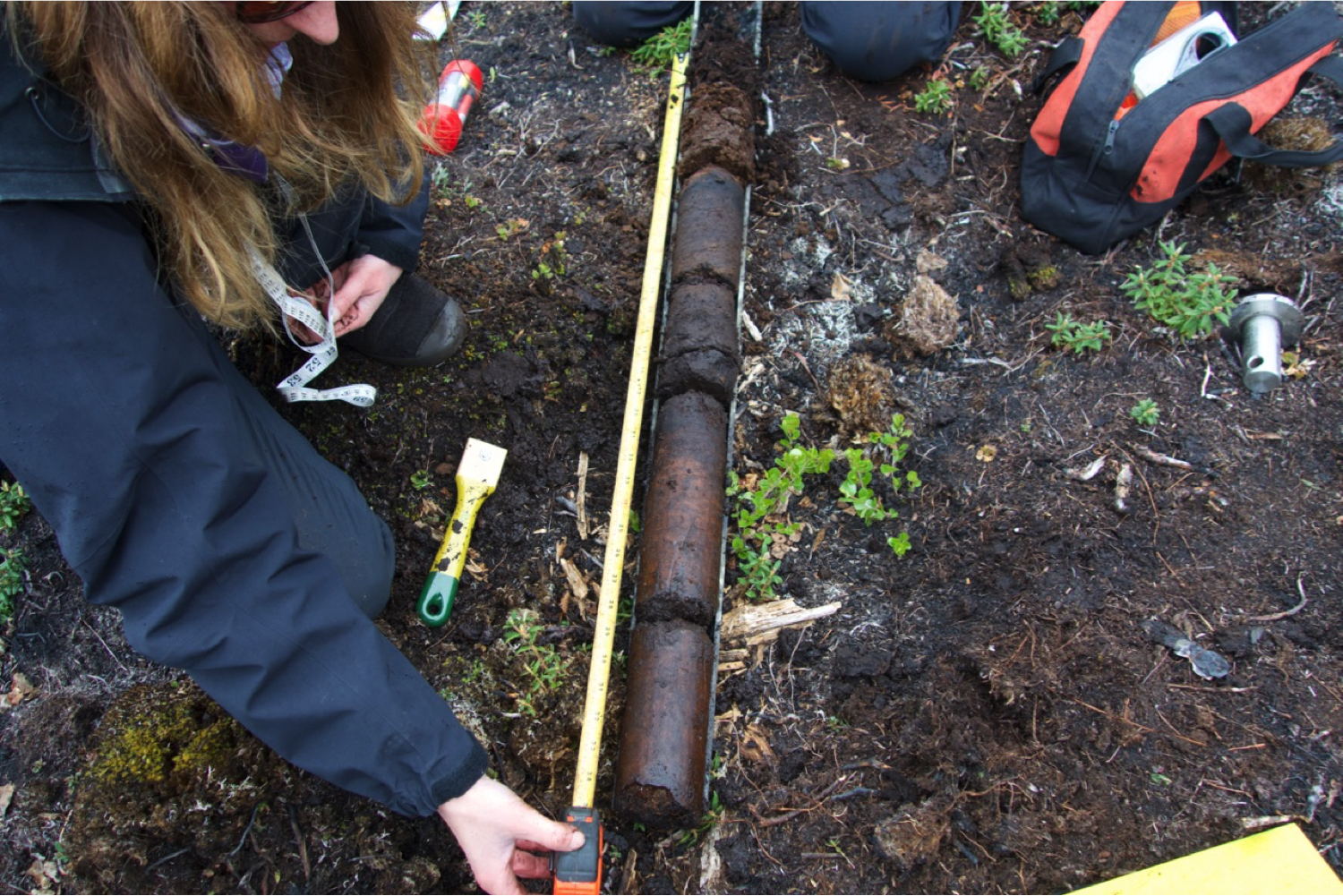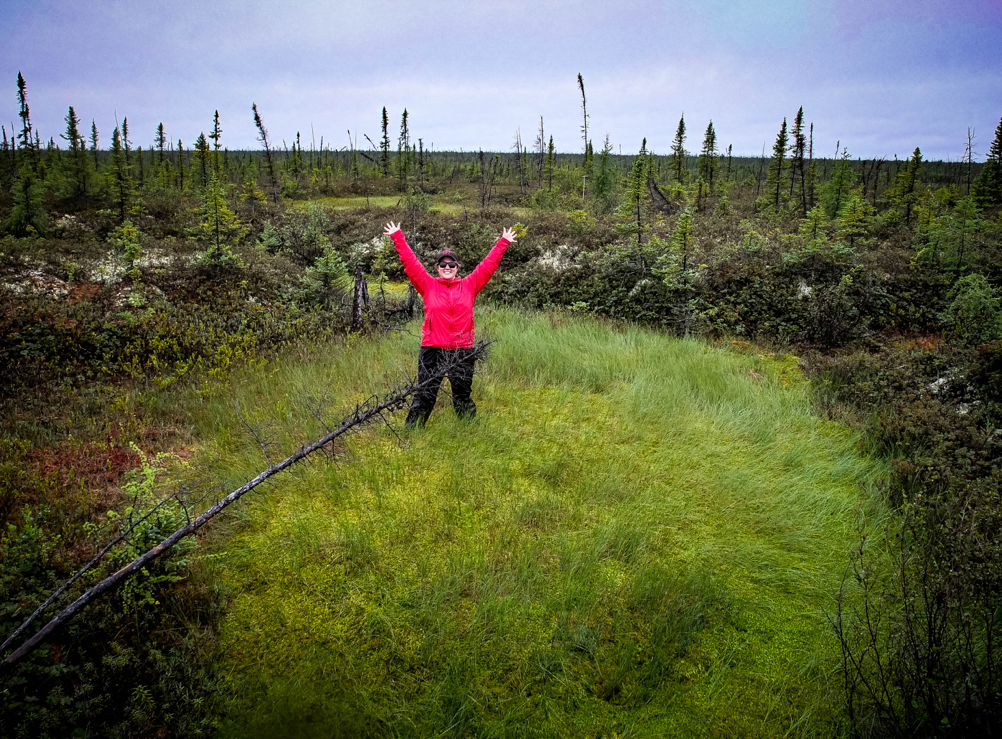
Shifting fire regimes in the far North threaten a delicate balance
As part of research on Arctic wildfires, Merritt Turetsky inspects a long soil core at a field site in the Northwest Territories of Canada in 2019. (Courtesy of Merritt Turetsky.)
As climate change warms the Arctic, fires are stripping protection from permafrost and changing boreal forest ecosystems.
The first time arctic ecologist Merritt Turetsky saw fire damage in her field sites, the sight brought tears to her eyes. “I’m a wetland person,” she said in a recent interview. “We don’t think of wetlands as being on fire.” Wetlands and peatlands burn every thousand years, it was thought.
But that’s changing. In the 25 years since Turetsky first spotted fire damage in a field site in the Arctic, her sites have burned many times, and Turetsky’s response has shifted from shock to curiosity. In an interview, Turetsky said she now strives to learn how the artic and boreal forest ecosystems are changing and how this knowledge could protect these fragile ecosystems
During a virtual talk released Oct. 16 as part of the ScienceWriters2020 conference, Turetsky called the summer of 2020 a “fever” for the Artic. Temperatures were above normal for most of the year and often exceeded 100 degrees Fahrenheit. The hot and dry conditions led to more fires in the Artic – a region that does not depend on fires to maintain its ecosystem. These changes in the Artic are leading to cascading effects such as increased carbon emissions, species changes, and changes to traditional ways of life for many people.
To the south of the Artic lies the boreal forest. Although cold, the boreal forest is a fire-dependent ecosystem. Much of the vegetation relies on fire to regenerate. The boreal forest and the Arctic, which border each other, both experienced lasting effects from more frequent fires.
Fires in the North occur below ground. “We tend to think of wildfires as licking up into the trees, the types of fire that Bambi ran from in the movie. That’s actually not how fires in the North occur,” Turetsky said. “Much of what burns is on the ground—the moss and the peat layers.”
These layers, which normally act as a wet blanket to protect the permafrost from melting, have gotten drier with increasing temperatures and changes in precipitation. The dry moss and peat burn easily.
“A beast that is hard to tame”
Fires are becoming deeper and more widespread in the boreal forest, turning its protective wet blanket into the perfect tinder to spark fires. And with changing climate conditions, these fires are pushing north into the Arctic, an area easily damaged by fire. As the moss and peat layers dry and burn, fires burn even deeper. Deep fires lead to more, and faster, melting of permafrost.
They also have a climate impact, Turetsky said. “Think about the kind of burning we get when our logs in our campfire are wet,” she said in her conference talk. Across the boreal forest, “that slow, inefficient burning releases a number of very powerful greenhouse gases,” including carbon dioxide, nitrous oxide, methane, and carbon monoxide. These fires can persist for months and cause rapid changes.
Remote sensing and field data indicate that animals and plants are already shifting because of the deeper fires. The Sitka spruce is one species that is a hallmark of the boreal forest. As fires burn deeper in the ground and erode the rich soil, the Sitka cannot compete with deciduous trees, which do better on these warmer soils.

Beyond the trees, there will be winners and losers among the animal species that call the far North home. Moose thrive in marshy ecosystems, and as the boreal forest burns and expands into the traditionally ice-covered landscapes of the Artic, moose will follow. The caribou, however, will suffer. Caribou, an icon of the north, rely on lichen-dominated environments. Lichen flourish on dry, frozen ground. As the permafrost thaws, the lichen will disappear—and likely won’t return for at least 50 years or more.
As caribou shift their habitat, Indigenous peoples in Canada and Alaska will have to adapt. These groups rely on healthy snowpack for safe travel across the region, following paths that generations have taken. In this way, Turetsky said, emissions of people to the south are dictating the lives of the people of the North.
The burning of moss and peat is not the only way these fires release carbon into the atmosphere. According to the Arctic Report Card of the U.S. National Oceanographic and Atmospheric Administration, recent estimates say that the permafrost stores twice as much carbon as there is in the atmosphere. If the permafrost continues to melt, the carbon emitted could be equivalent to adding another industrialized nation to the carbon budget. When closing her talk, Turetsky said any plans to slow climate change must consider the rapid emissions of an ecosystem that has long been a massive carbon sink.
When Turetsky returns to her field sites each year, she never knows whether she’ll find ice or a new lake. She believes we have time to protect the Arctic—but not a lot. “Once the permafrost thaws, it has momentum,” she said during a live Q&A following her talk. “It is a beast that is hard to tame.”